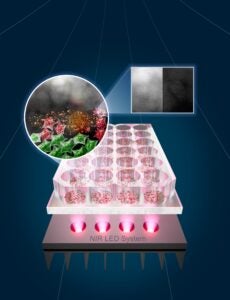
A groundbreaking cancer treatment utilizing LED light combined with tin nanoflakes has been developed to target and neutralize cancer cells while sparing healthy ones, potentially avoiding the painful side effects of traditional therapies. This innovative approach is a collaboration between The University of Texas at Austin and the University of Porto in Portugal, facilitated by the UT Austin Portugal Program.
The new method promises to overcome significant barriers faced by existing light-based treatments, such as high material costs and the requirement for specialized facilities. By employing LED technology instead of lasers, and using a novel cancer-targeting material known as “SnOx nanoflakes,” researchers aim to make this therapy more accessible and safer.
Breakthrough in Cancer Treatment
Jean Anne Incorvia, a professor at the Cockrell School of Engineering’s Chandra Family Department of Electrical and Computer Engineering, highlighted the dual focus on effectiveness and safety. “With the combination of LED light and SnOx nanoflakes, we’ve developed a method to precisely target cancer cells while leaving healthy cells untouched,” she stated.
Published in the journal ACS Nano, the study demonstrated remarkable results. In just 30 minutes, the treatment eradicated up to 92% of skin cancer cells and 50% of colorectal cancer cells, without adverse effects on healthy human skin cells. This underscores the treatment’s potential as a selective and safe cancer therapy.
Context and Challenges in Cancer Treatment
Cancer remains the second-leading cause of death globally, with current treatments often being invasive or carrying severe side effects. Researchers are exploring alternatives like near-infrared photothermal therapy, which uses light to selectively heat and destroy cancer cells. This approach forms the basis of the UT-Portugal team’s research.
Their success in targeting cancer cells while preserving healthy tissue marks a significant advancement in the field. The researchers now aim to further understand the light and heat reactions involved and explore additional catalyst materials to enhance the treatment’s efficacy.
Future Developments and Accessibility
Artur Pinto, a leading researcher at the Faculty of Engineering of the University of Porto, expressed the team’s vision for widespread accessibility. “Our ultimate goal is to make this technology available to patients everywhere, especially in areas with limited access to specialized equipment, with fewer side effects and lower cost,” he explained.
For skin cancers, Pinto envisions a future where treatment could transition from hospitals to homes. A portable device could be used post-surgery to irradiate and eliminate any remaining cancer cells, significantly reducing the risk of recurrence.
Collaborative Efforts and Future Prospects
The collaboration between Incorvia and Pinto, initiated through the UT Austin Portugal Program in 2021, has led to several breakthroughs. Their ongoing partnership, supported by mutual visits and shared expertise, continues to explore the potential of two-dimensional materials in cancer treatment.
This year, the team secured additional funding to develop an implant for breast cancer patients, building on their promising findings. The research team includes Ph.D. student Hui-Ping Chang, who led the development of the nanoflakes, and undergraduate student Eva Nance from The University of Texas at Austin. From the University of Porto, contributors include Filipa A.L.S. Silva, Susana G. Santos, and professor Fernão Magalhães, alongside José R. Fernandes from the University of Trás-os-Montes and Alto Douro, who developed the LED systems.
The UT Austin Portugal Program, a longstanding partnership with the Portuguese Foundation of Science and Technology (FCT), continues to foster scientific and technological advancements. Portugal’s collaboration with UT, recently renewed for another five years, is part of its broader strategy of partnerships with leading U.S. institutions, including MIT and Carnegie Mellon University.
As the research progresses, the potential for this LED-based treatment to revolutionize cancer care and improve patient outcomes remains a hopeful prospect for the medical community worldwide.







